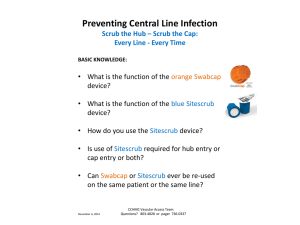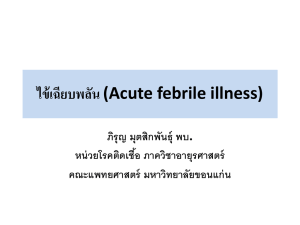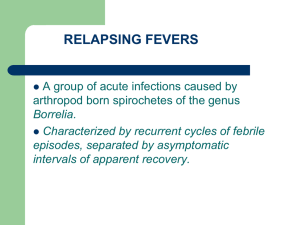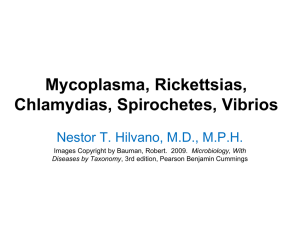J Assoc physic India
advertisement
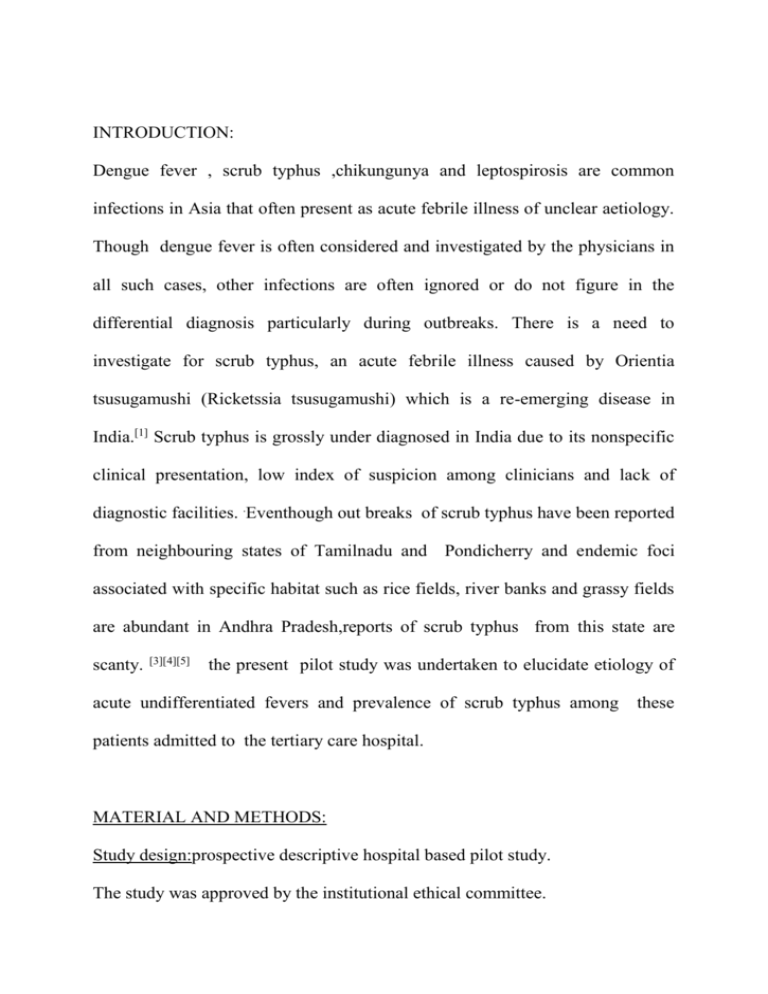
INTRODUCTION: Dengue fever , scrub typhus ,chikungunya and leptospirosis are common infections in Asia that often present as acute febrile illness of unclear aetiology. Though dengue fever is often considered and investigated by the physicians in all such cases, other infections are often ignored or do not figure in the differential diagnosis particularly during outbreaks. There is a need to investigate for scrub typhus, an acute febrile illness caused by Orientia tsusugamushi (Ricketssia tsusugamushi) which is a re-emerging disease in India.[1] Scrub typhus is grossly under diagnosed in India due to its nonspecific clinical presentation, low index of suspicion among clinicians and lack of diagnostic facilities. .Eventhough out breaks of scrub typhus have been reported from neighbouring states of Tamilnadu and Pondicherry and endemic foci associated with specific habitat such as rice fields, river banks and grassy fields are abundant in Andhra Pradesh,reports of scrub typhus from this state are scanty. [3][4][5] the present pilot study was undertaken to elucidate etiology of acute undifferentiated fevers and prevalence of scrub typhus among patients admitted to the tertiary care hospital. MATERIAL AND METHODS: Study design:prospective descriptive hospital based pilot study. The study was approved by the institutional ethical committee. these One hundred febrile patients admitted in medical and paediatric wards of gandhi hospital during october 2011-november 2011 were included in this study. Inclusion criteria were : patients of all age groups , having temperature >38.5c for >24 hrs and clinically diagnosed as having dengue fever. Exclusion criteria were : febrile cases with definite source of infection, history of bleeding tendency since birth, immunocompromised patients. Information on demographic features and symptoms of the patients were collected by a structured questionaire and consent was obtained.A detailed physical examination and tourniquet test was done.Single serum sample collected from all these patients within 48hours of admission was subjected to the following serological assays- dengue NS1 antigen ELISA(Panbio), dengue IgM ELISA((NIV Pune), dengue IgG ELISA (Novatech), chikungunya IgM antibodies MAC- ELISA(Panbio) , widal tube agglutination test(Span diagnostics),leptospira IgM antibodies ELISA (Panbio),Plasmodium falciparum, Plasmodium vivax antigen Parahit FandV(Span diagnostics),Weil Felix tube agglutination test(Tulip diagnostics) ,Orientia tsusugamushi IgM and IgG antibodies Rapid mmunochromatographic test (SD bioline). All the tests were performed according to manufacturer’s instructions. In widal test “O”antibody titres of >1 in 80 dilutions and “H”antibody titres of >1 in 160 dilutions was considered positive.Other laboratory investigations included haemoglobin, total and differential leukocyte count, platelet count and liver transaminases. Statistical analysis was done by chi square test.p value <0.05 is considered significant, and <0.001 as highly significant. RESULTS: Table 1 shows the serological profile of acute febrile illness patients. Thirty nine patients were positive for dengue ns1ag and/or dengue igm antibodies.19 samples were positive for scrub typhus by rapid immunochromatography.14 samples showed a titre of > 320 and 5 samples showed a titre of 80 to 160 by weil felix test. Table 2 shows the clinical and laboratory differentiating features between dengue fever and scrub typhus. scrub typhus was more common in older age group(36.2yr)compared to dengue fever(20.8yr). Tourniquet test and signs and symptoms suggestive of platelet dysfunction were common in dengue fever whereas these findings were uncommon in cases with scrub typhus. DISCUSSION: Most of the acute fevers presenting with rash are presumptively diagnosed as dengue fever, especially during monsoon and post monsoon months in tropical countries like India. However only up to one third of the cases are confirmed as dengue. In our study even after including NS1 antigen test, dengue fever contributed to 39% whereas other infections contributed to 40% of cases .similar observations were done by other workers.[ 4] In India, the presence of scrub typhus has been known for several decades. During world war II scrub typhus produced considerable mortality and morbidity among troops deployed in South East Asia. However in later years the disease virtually disappeared, probably because of wide spread use of insecticides to control other vector borne diseases. Recent reports from several parts of country including South India indicate that there is a re- emergence of scrub typhus.[1][3][4][5] Diagnosis of scrub typhus is most often confirmed by serological testing. Specific gold standard tests like Immunoflourescence antibody test (IFA), Immunoperoxidase test (IP) , ELISA and isolation are not available in our country .Many reports from Indian subcontinent are based on clinical findings and nonspecific Weil Felix test [6] Criteria suggested for diagnosis of scrub typhus is a single titer of 1:320 or four fold rise in antibody titer rising from 1:80.in weil Felix test . In our study antibody titer was 1:320 in 14 cases (73.7%) and low titer of 1:80-1:160 were detected in 5 cases. Rising antibody titer could not be demonstrated as we could not collect the convalescent sera. These samples tested positive with the immunochromatography which employed a 56kda recombinant protein specific for o.tsusugamushi for detection of igm and igg antibodies with a reported sensitivity of 97% and specificity of 100%[7][8][9].hence these samples were also considered positive for scrub typhus antibodies.further none of these samples were positive for other serological tests performed. Most cases of scrub typhus were from rural background.Tourniquet test ,signs and symptoms suggestive of platelet dysfunction were common in dengue fever in contrast to scrub typhus.These features can be useful in clinical diagnosis in differentiating between dengue fever and scrub typhus and initiation of specific antibiotic therapy for scrub typhus which will reduce the morbidity and mortality.Similar observation was made by other workers [10]. In our study Scrub typhus contributed to 19% of the acute fevers and 31.1% of other than dengue fever. To the best of our knowledge except for a case report , there are no reports on the prevalence of scrub typhus in Andhra Pradesh. This study emphasizes the need for the general awareness of ricketssial infections in Andhra Pradesh.Diagnostic tests using 56 KDA antigens specific for Orientia tsutsugamushi can provide a cost effective alternative diagnostic tool. More research is essential regarding the epidemiology, pathogenesis and lab diagnosis of diseases in Indian context particularly in Andhra Pradesh. REFERENCES: 1. Mahajan.SK, Scrub typhus.J Assoc physic India 2005;53: 954-8. 2. Sharma.S, Rakesh.K, Kaore.SN, Yadav.VK, Sharma.R geographical distribution, effect of season and life cycle of Scrub typhus. www.JKScience.org 2010;12(2):63-4. 3. Mahajan.SK, Kashyap.R, Sharma.V, Prasher BS, Pal.LS Relevance of Weil-Felix Test in diagnosis of Scrub typhus in India. J assoc Physic India 2006;54: 619-21. 4. Vivekanandan.M, Mani.A, Priya.YS, Singh AP, Jaya kumar.S, Purty.S. Out break of Scrub typhus in Pondicherry. J assoc Physic India 2010;58: 24-8. 5. Boorugu.H. Dinakar.M, Roy ND, Juda.JA. Reporting a care of Scrub typhus from Andhra Pradesh. J.Assoc.Physic India 2010;58:519. 6. Chogle.AR. Diagnosis and treatment of Scrub typhus – the Indian Scenario. J Assoc.Physic India 2010;58:11-2 7. Iraac R,Varghare GM,Mathai E,Manjula J,Jorph I.Scrub typhus:Prevalence and diagnostic issues in rural Southern India.Clin Infect Dis 2004;39:1395-6. 8.Ching WM,Rowland D,Zhaug Z,Bourgeosis AL,Kally D,Dasch GA etal.Early diagnosis of scrub typhus with a rapid flow array using major recombinant outer membrane protein (r56) of O.tsusugamushi.Clin Diagno Lab Immunol.2001;8:409-14. 9.Lijuan Z,Si H,Yuming J,Liang L,Xuemei L,Lianying L,Hiirlan X,Qiang Y,Chirangfu C,Shiwen W.Arapid sensitive and reliable diagnostic test for scrub typhus in China.Indian J Med Microbiol 2011;29(4):368-71. 10.George Watt, Krisada Jongsakul, Charoen Chouriyagune, And Robert Paris. Differentiating Dengue Virus Infection From Scrub Typhus In Thai Adults With fever Am. J. Trop. Med. Hyg., 2003; 68(5): 536–538


